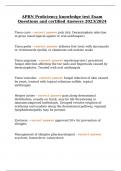APRN Proficiency knowledge test Exam
Questions and certified Answers 2023/2024
Tinea curis - correct answer jock itch. Dermatophyte infection
in groin (used topical agents or oral antifungals)
Tinea pedis - correct answer athletes foot treat with miconazole
or clotrimazole (pedis) or aluminum sub acetate soaks
Tinea unguium - correct answer onychomycosis ( persistent
fungal infection affecting the toe nails and fingernails caused by
dermatophytes. Treated with oral antifungals
Tinea vesicolor - correct answer fungal infection of skin caused
by yeast, treated with topical selenium sulfide, topical
antifungals
Herpes zoster - correct answer pain along dermatomal
distribution, usually on trunk, may be life threatening in
immunocomprised individuals. Grouped vesicles eruption of
erythema and exudate along the dermatomal pathway, regional
lymphadenoapathy may be present.
Zostavax - correct answer approved 50> for prevention of
shingles
Management of shingles pharmacological - correct answer
acyclovir, famciclovir, valacyclovir
,Actinic keratosis - correct answer small patches occurring on
sun-exposed parts of the body. Pre-malignant (1:1000) lesions
progress to squamous cell carcinoma. Systematic, small patches
may be tender, fought, flesh colored, pink and hyperpigmented
Squamous cell carcinoma - correct answer arise out of actinic
keratoses; firm , irregular papule or nodule, develop over few
months 3-7% metastasize, prolonged sun-exposed areas in fair
skin people, keratitic, scaly bleeding
Treatment of squamous cell carcinoma - correct answer biopsy
and surgical excision (mohs)
Seborrheic keratoses - correct answer benign, not painful
lesion, beigh, brown, or black plaques, stuck on appearance, 3-
20cm
Basal cell carcinoma - correct answer most common skin
cancer; slow growing; grows 1-2 cm in years; waxy, pearly
appearance (may be shiny red), central depression or rolled
edge; may have telangiectatic vessels
Treatment of basal cell carcinoma - correct answer shave/punch
biopsy and surgical excision
Malignant melanoma - correct answer mortality rate highest of
all skin cancers; mediate age of diagnoses 40, may spread to any
organ abcde
, What does abcde - correct answer asymmetry, border
irregularity, color variation, diameter >6cm, elevation,
enlargement. Treatment is biopsy and surgical excision
Eczema - correct answer chronic skin condition characterized
by intense pruritus, acute flare ups: red shiny, thickened patches,
inflamed/scabbed and erythema, scaling, dry leathery
lichenification treated with topical steroids, rubbed ins ell:
clobetasol cream
Allergic contact dermatitis - correct answer acute or chronic
condition characterized by inflammation at the site of contact
with chemical allergens (redness, pruritus, scabbing, sharp
defined borders) treat with topical steroids , do not scrub with
soap and water, prednisone taper if severe
Psoriasis - correct answer benign hyperproliferative
inflammation of the skin that can be acute or chronic. (hiv: may
present as a first sign of hiv infection (explosive event); itching
red, precisely defined plaques with silvery scales, fine pitting of
the nails, (auspitz sign: droplets of blood when scales removed)
treatment is topicals for scalp (tar, salicylic acid shampoo and
topical steroids (betamethasone) uvb light exposure.
Pityriasis rosea - correct answer mild acute inflammatory
disorder more common in females (50%> males) during spring
and fall; pruritic rash found on trunk and proximal extremities;
initial lesion is 2-10cm "herald patch" generalized rash presents
within 1-2 weeks' ;lesions follow a christmas tree pattern (follows
cleavage lines on the trunk) eruption can last 4-8 weeks.
***serologic test for syphyllis should be done if lesions are not
itching, lesions are present on palmar or plantar surfaces (this
was on our exam)**and lesions are few and perfect




